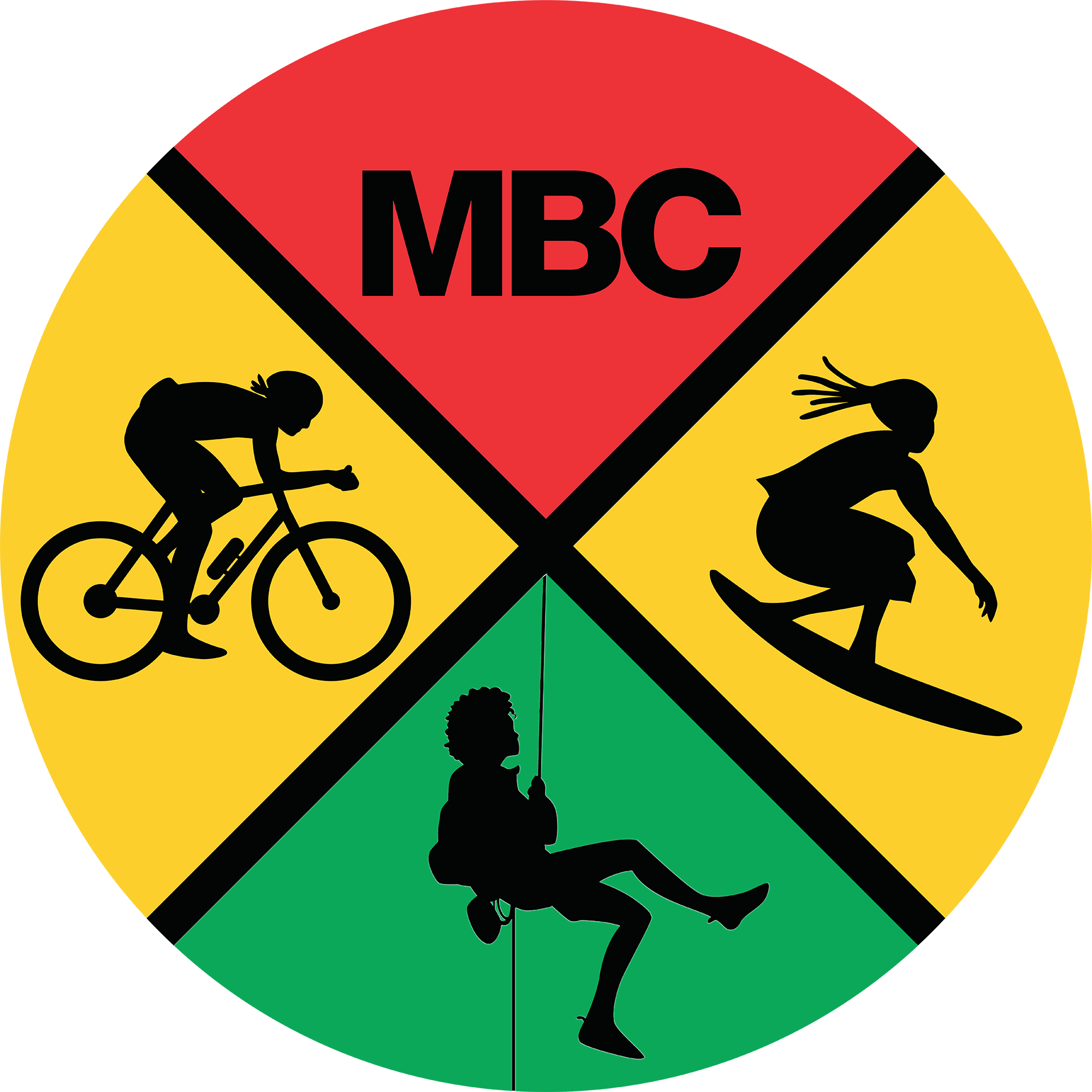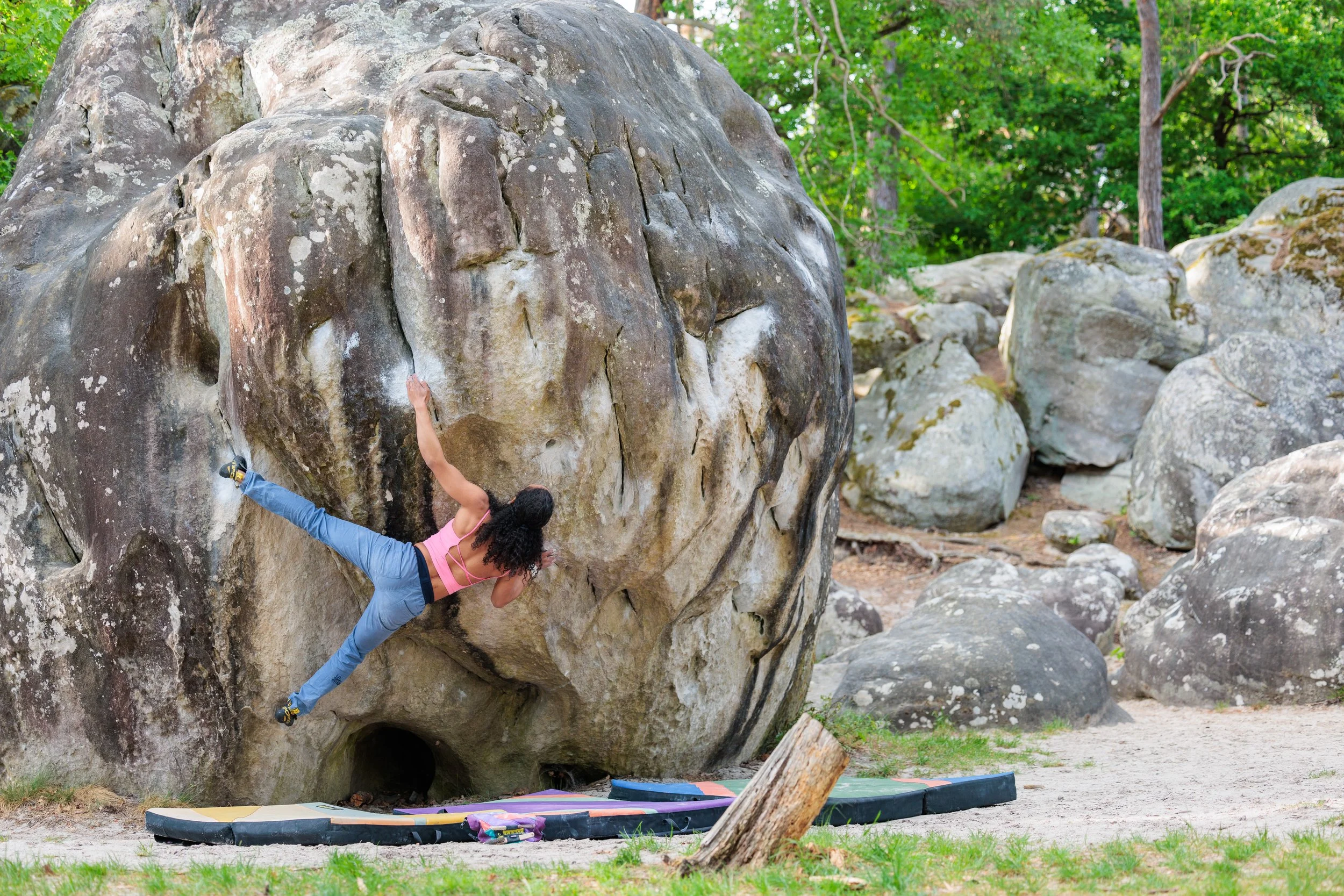the climbing doctor
Instagram: @felinefavia | Website
Dr. Favia Dubyk is a New Mexico based climber, wife and mom to rescue pup Hans. Want to know how to stay resilient through outdoor adventure sports? Favia climbed her way through a cancer diagnosis, chemotherapy and recovery. On weekends you can find her mountain biking with her partner and bouldering with her crag dog Hans. You can also catch her on Season 10 of American Ninja Warrior!
Name: Favia
Hometown: Albuquerque, NM
Occupation: Pathologist
Sport: Bouldering
What got you into climbing? Google! I was visiting my parents at home—they lived in Nashville—and I was tired of going to the mall and movie theaters. So, I googled what to do in Nashville, TN and I came up with rock climbing. I tried it one time and I fell in love! Later on, I started grad school at Columbia. They had an activities festival and they offered a climbing gym membership for 75% off. Climbing is really expensive—especially in Manhattan. I said I’m going to get this! So I bought it. I went to the gym and I actually didn’t like it. I was going to this new place alone. It was kind of scary. I was new to Manhattan. I didn’t know anybody. Later I was getting ready to graduate and I still had this unused membership. I told myself, Favia, you’re going to go at least eleven times to break even. By the seventh trip I was hooked. At that point I still thought climbing was a climbing gym. I had never heard of sport climbing or trad climbing. Then I went to med school and started climbing at the gym there. People asked me if I wanted to go outside and climb. My reaction was: ‘what do you mean? What are the holds? Who set the problems?’ It was in Cleveland that I discovered that climbing was an entire community. You could go indoors or outdoors.
What made you decide to become a Pathologist? I started med school thinking I wanted to become an orthopedic surgeon. Then I got cancer. I had multiple surgeries to figure out what sort of cancer I had, but the diagnosis was not straightforward. In addition, I had these horrible, life threatening complications from the surgeries. While living in the hospital, I remember the doctors saying we’re waiting for Pathology. Waiting for Pathology. I remember thinking, man I’m waiting for Pathology; my whole life is depending on Pathology. I decided if I make it through this I want to become a Pathologist. And so I did. It was definitely the best career choice I could have made.
Have you tried any other adventure sports? Mountain biking! My husband got me into that. I have a mountain bike and I’ve done some trails with him.
What made you fall in love with bouldering? The gym where I first started was mainly a bouldering gym. I just fell in love with it! I have dabbled in sport climbing; however, sport climbing requires a partner, someone to belay you, so it’s harder to coordinate. With bouldering, all I need is my dog, shoes, and a crash pad! Also, I enjoy the short hard movements of bouldering. I was a sprinter in college and that just sort of translates. Bouldering is like a sprint. I like the atmosphere. People just sit around the rock, staring at it, eating food, talking beta. You go from sitting down to trying your hardest on the rock, then go back to sitting down. I think that appeals to something innate in me. I know a lot of people like to climb to gain vertical height, to get the views. I climb because I like the movement.
What about top roping or lead climbing? To be quite honest, belaying terrifies me. I can lead climb. I’m not afraid of falling but belaying, having somebody’s life in my hands, particularly somebody heavier, dropping somebody is just very scary. Most people don’t feel this way. I climb because it’s fun and relaxing and currently, belaying adds more stress. One goal I have for 2018 is to become more comfortable belaying.
How tall are you?( 5’2.75”) Does height make a difference in bouldering? You normally hear about the stereotype of power moves vs agility in descriptions of men's vs women's climbing. Is any of that accurate or does it all depend on the individual? So I think that historically people think of women as very technical climbers and men as more dynamic climbers but I don’t think that holds true whatsoever. I know men who can go slow and very technical and women who can jump. Height helps but it doesn’t always help. Recently in the news, professional climber Margo Hayes became the first woman to send a 5.15a. Margo Hayes, Alex Puccio, and so many strong female climbers in the world are demonstrating that women climbers can do whatever men can do! I personally like roofs and powerful moves. I would describe my climbing style as powerful and static.
What do you enjoy most about bouldering? My favorite part of climbing is the sensation of having my life hanging by my fingertips. I like being in control of my body, and the power I feel in my fingers. I like that I can contort into weird positions to send a project. I really enjoy solving puzzles. So many options. So many features on the rock. How do you decide which hold to use? I like the trial and error process. Bouldering is a puzzle that has to be solved with core, muscle, finger strength. In addition, I love the atmosphere of hanging with my friends during bouldering trips. It’s pretty much like being on a team again.
How do you feel about beta? I like beta. I do. In medicine if someone has already figured something out we don’t reinvent their test. I like to see how someone else has solved the puzzle.
What has your experience been as a Woman of Color in the climbing community? I think there’s two parts. Being a woman in climbing. And being a person of color in climbing. Being a woman some people may make assumptions that you can’t do certain things. If you’re new to a place and there with your male climbing partner people might only ask the man for beta but not the girl. That’s one difficulty that I’ve experienced. Regarding being a person of color in this climbing community: there are some cultural differences that I guess have been a learning experience. I have learned so much about the outdoors that I didn’t know growing up. When I talk to someone who has grown up in the woods who may expect me to have certain skills which I don’t have I find myself explaining that this is new to me. I’m discovering the outdoors at an older age. because I didn’t grow up in it. How to hike and climb at night. How to pee outside. How to check holds for bugs (I’m terrified of bugs). Once when I was at the Red sport climbing there was a giant spider on my route. It was huge! And it was on the only available hold. I screamed. Everyone thought something bad had happened and I yelled there was a spider. They all laughed. I got my wits about me: it’s just a spider, you got to get around it, and it’s not going to hurt you. Afterwards I told them I don’t appreciate them laughing at my fear. They didn’t know that it was really terrifying for me. Afterwards, they were better at not making fun of something that really does scare me. I will say the community is usually very open and very accepting. Now when I go out and I climb, I’ve discovered, #diversifyoutdoors organizations like Brown Girls Climb are a connect. It’s really great because it allows us to find other women climbers of color.
Tell me about your crag dog! Crag dogs! Hans! He’s my crag dog. He’s part Rottweiler part Doberman. 100 percent sweet. I absolutely love him and he makes a great bouldering partner. I don't go climbing without him! I just wish I could make a crag cat out of my five felines.


































Building a home gym is a monumental task! Once the climbing wall is built, you’d think the biggest hurdle is over. But a safe landing area is just as important, and can be just as overwhelming. There are many options for foam and foam coverings, making it difficult to know which is right for a climbing wall. I spent weeks reading about foam, cold-calling foam companies, and driving around to different fabric stores learning about vinyl coverings. Here is my journey of building a safe landing!